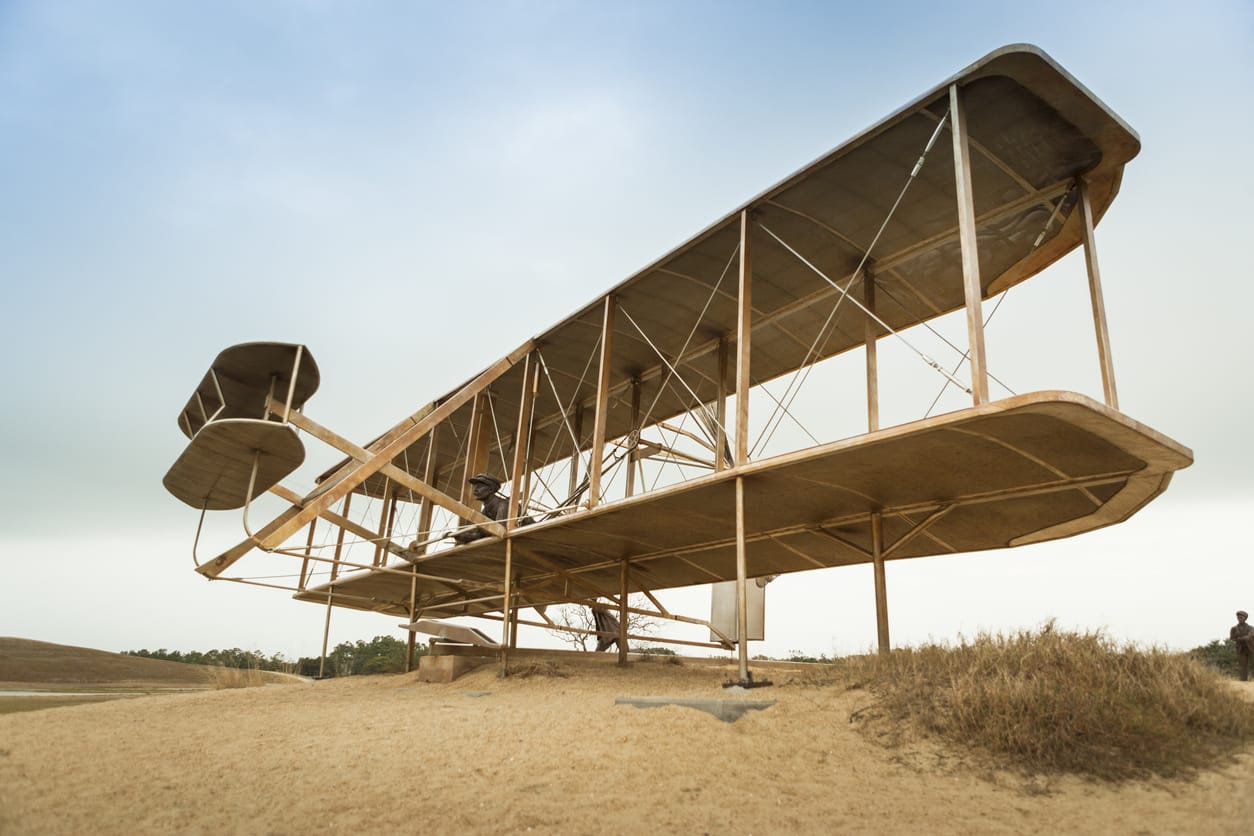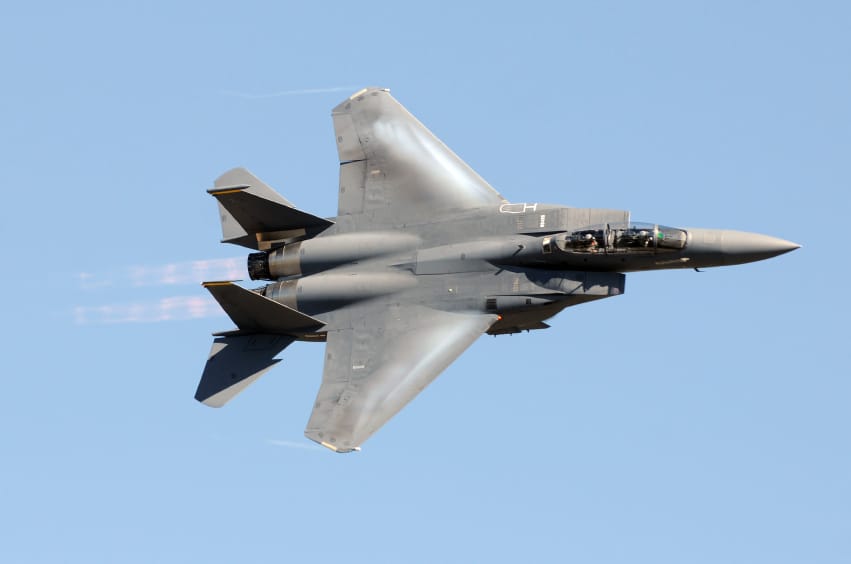Air travel and transport are so interwoven in our everyday existence that it’s difficult to imagine life without it. But at one time, aviation was considered an impossibility, then a dangerous stunt, then a luxury. It’s since transformed the human experience and connected the planet in ways not thought possible.
The history of man and sending objects aloft can be traced back to kites in China before the birth of Christ, medieval thoughts on man-powered lifting machines such as Leonardo da Vinci’s helicopter, the hydrogen balloons of the 18th century, and early attempts at flying machines at the turn of the 20thcentury. The beginning of aviation history, however, is usually pegged at 1903, when a bicycle salesman from Ohio flew a powered airplane for twelve seconds over a distance of 120 feet.
The Wright Flyer, 1903
It’s incredible that several movies haven’t been made about the astonishing story of brothers Wilber and Orville Wright, who ran a bicycle repair shop in Dayton by day and applied themselves to solving the centuries-old riddle of powered flight by night. First having achieved success with gliders, they moved to designing and building engines powerful yet light enough to support both man and machine.
By focusing their research on control of the surfaces of a flying machine, the self-taught brothers were able to beat out a lavish airplane project funded by the U.S. Army, the work of several British pioneers, glider innovations by Chicago engineer Octave Chanute, daring glider flights in Germany by Otto Lilienthal, and the advancements of French inventor Clement Ader, who foresaw the development of the aircraft carrier.
The Wrights put to work their understanding of how bicycles glide and bank with their studies of the wheeling gulls at their favorite testing site in Kill Devil Hills, NC. They built their own wind tunnel in Ohio and addressed conundrums involving pilot control and crosswinds rather than power, which was their key to succeeding where other pioneers had failed. By 1909, their steadily improving aircrafts permitted them to make flights of up to an hour and circle the Statue of Liberty.
Wing Warping, Roll Control, Ailerons, and Flaps
While the Wrights are justly credited with the first powered and controlled flight in an airplane, this spectacular achievement overshadows their other innovations. Their main modernization involved wing warping, which allowed the pilot of their Flyer to correct for wind gusts. The brothers attached cables to the wings, which permitted them to twist the surfaces. This awarded them roll control: Safe, tight turns in the air were now possible.
Once the Wright brothers established the need for wing warping to ensure safe and extended flight, innovations piled on. A French pioneer, Robert Esnault-Pelterie, quickly made the brothers’ wire system obsolete by designing ailerons (French for “little wings.”) Ailerons, placed near the tip of the trailing edge of the wing, were a major step forward in maintaining control while in flight.
The first flaps appeared as early as 1916. This significant breakthrough helped pilots efficiently use power in increasingly sophisticated aircraft, allowing them to control for the various phases of flight. The outbreak of WWI helped to speed along the development of the airplane, particularly as a weapon.
Airplanes in WWI: Air Power as a Weapon
Just as blimps and balloons were used earlier in warfare to assess terrain and the movement of enemy troops, airplanes were indispensable in the conduct and spread of World War I. Airplanes were first used in scouting activities, then bombing runs and dogfights. Synchronized machine guns appeared early but took time to perfect, as pilots often found themselves clearing gun jams in addition to attempting to fly the airplane. By necessity, maneuverability and efficiency were pushed to the limit. The rise in airplanes as weapons in turned spurred rocket development as warring nations struggled to down enemy craft.
Rise of Monoplanes
The evolution from biplanes to monoplanes represented another major development in aviation. While some monoplanes were contemporaries of the Wright aircrafts, they weren’t generally seen until after WWI, when maneuverability demands began to outstrip the abilities of the biplane. Today, the vast majority of aircraft in the sky are monoplanes.
Airflow between wings situated next to one another proved a far more efficient model than the stacked-wing style of the biplane. While some monoplanes appeared in World War I, the monoplane didn’t become standard until the interwar period, when engines became more and more powerful, preparing the stage for the airplane-dominated Second World War.
Jimmy Doolittle and the First Instrument Flight
While a massive breakthrough in the development of aviation, the general public largely doesn’t recognize the importance of Jimmy Doolittle’s first fully instrumented flight in 1929. Doolittle’s accomplishment demonstrated the advancement of cockpit technology.
Doolittle is largely known for his later feats—his tremendous role in the aviation of World War II, particularly the Doolittle Raid — but his other, earlier marks on aviation are significant. Then a lieutenant in the U.S. Army Air Corps, Doolittle took off and landed at Mitchel Field in New York. He did so completely blind, flying by instruments only. A safety pilot accompanied him in the front seat of an NY-2 Husky as Doolittle placed a hood over his seat in the rear cockpit.
Doolittle flew by altimeter, artificial horizon, and an early form of a gyroscopic compass. Although crude by today’s glass cockpit standards, Doolittle’s flight represented a massive step forward from a single pilot lying between the wings of the Wright Flyer only two decades prior. The flight was practically considered a feat of science fiction, relying as it did on radio beacons, receivers, and the barometric altimeter. Indeed, the flight took place in a stable training aircraft and was considered experimental.
Like the Wright Brothers, Doolittle recognized that advancement for aviation was dependent upon the pilot’s ability to control the aircraft in a multitude of conditions. His flight helped to lay the groundwork for the development of radar and radio beacons, which revolutionized flying in poor conditions.
Read More:
Ready to soar in your aviation career?
Mr. Matthew A. Johnston has over 23 years of experience serving various roles in education and is currently serving as the President of California Aeronautical University. He maintains memberships and is a supporting participant with several aviation promoting and advocacy associations including University Aviation Association (UAA), Regional Airline Association (RAA), AOPA, NBAA, and EAA with the Young Eagles program. He is proud of his collaboration with airlines, aviation businesses and individual aviation professionals who are working with him to develop California Aeronautical University as a leader in educating aviation professionals.

